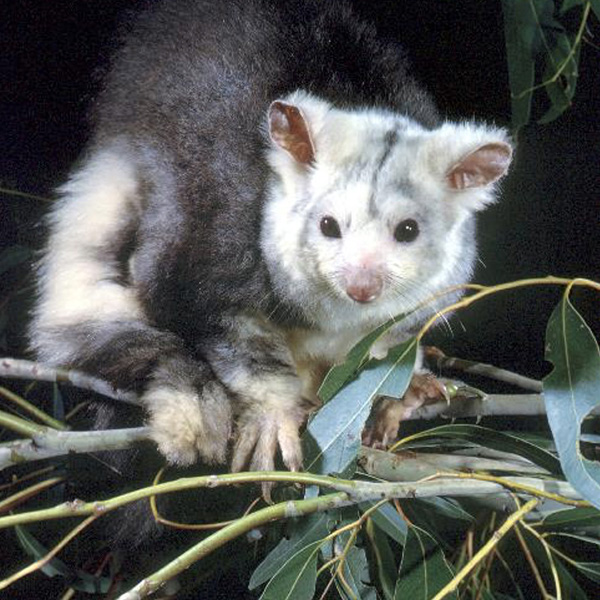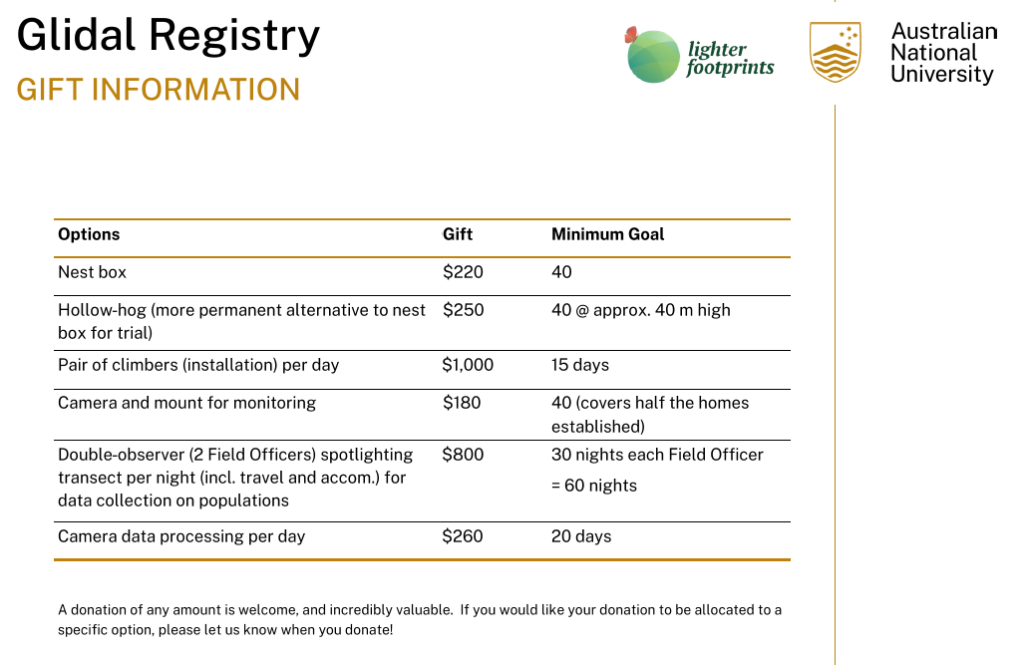Our 27th September public meeting at the Balwyn Park Centre was a standing room only event. You can view the event here.
We welcomed a capacity crowd and listened intently to the three passionate forest defenders; Professor David Lindenmayer from ANU with Sue McKinnon and Aawa White from Kinglake Friends of the Forest.
Speakers slide sets are available:
- View Professor David Lindenmayer’s slideset here
- View Sue McKinnon’s slideset here
- View Aawa White’s slideset here
Our forests need us.
We cannot let the Victorian State Government’s mid year announcement that logging will end at the end of 2023 lead us to complacency. The consequences of logging will be with our communities for many years. Our forest ecosystems will require the concerted actions of scientists and citizen scientists to redress the wrongs of many decades.
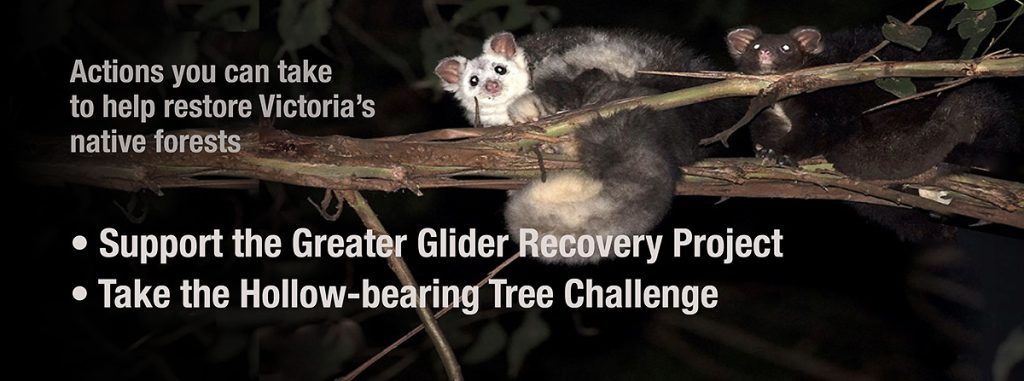
There are positive actions we can take.
- Support the Greater Glider recovery project with ANU. Help provide fire resistant, insulated nest boxes where Greater Gliders need them most. Check out our five minute video presentation here, including extra footage of nest box construction, installation and Greater Gliders.
- Hollow bearing Tree Challenge – contribute valuable citizen science data about hollow bearing trees. More details below, and link to an easy A4 instruction sheet here!

Lighter Footprints Forests Working Group hosted Victoria’s Native Forests – State of Play, featuring Professor David Lindenmayer from ANU and Sue McKinnon and Aawa White from Kinglake Friends of the Forest
Throughout the whole event, David, Sue and Aawa provided the audience with new knowledge of what has been happening and practical opportunities to support a future for forests and their inhabitants.
Scientific research and citizen scientists capturing data and mounting arguments against state instrumentalities in the courts have made a difference and altered the course of history where forests are concerned.
Professor David Lindenmayer

Logging exacerbates fire, and logging and fire are driving severe reductions in old growth forests.
Key Science Insights
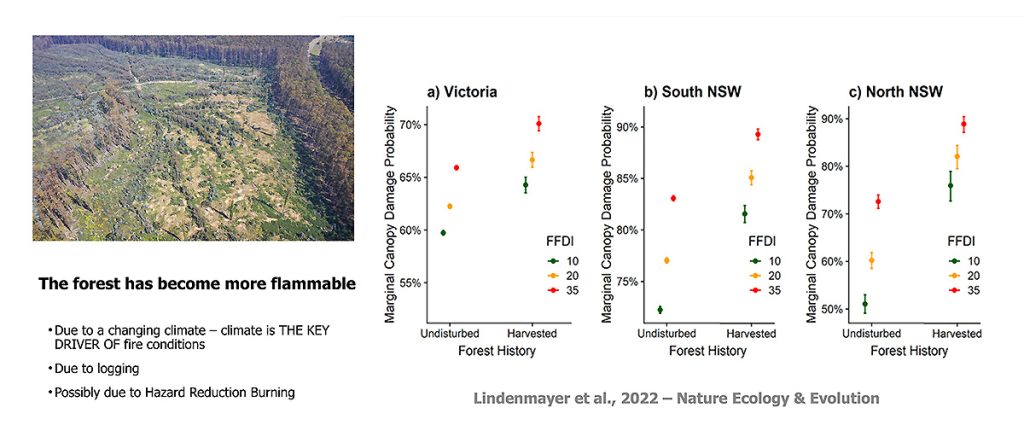
Undisturbed forests are more resilient. Global heating is increasing fire risk, logging makes this worse.
Professor David Lindenmayer’s critical insights:
- Recurrent fire and logging have resulted in a 77% loss of old growth since 1995.
- Fire sizes and occurrences are increasing in certain areas, with climate being a pivotal driver of fire.
- Logged forests consistently burn with higher severity and can pose a greater fire risk compared to unlogged forests even under moderate weather conditions.
- Approaches such as hazard reduction, burning and thinning have yielded mixed results and, in some cases, exacerbate fire severity.

Logging always increases fire severity.
Hazard Reduction Burning
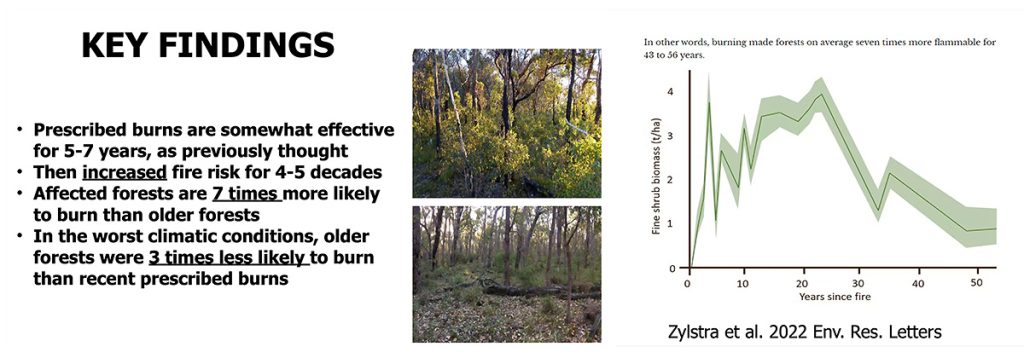
Prescribed burns only have a temporary protective effect. They increase fire risk many times for decades afterwards.
- The key is quality not quantity
- Should be focused on less than 1 km from infrastructure – not in remote areas
- Done every few years
- Distant burning to hit targets has limited effectiveness and does not always work. For example, Marysville.
- It’s wrong to say “if only we had done more hazard reduction burning” with regards to risk reduction (especially under extreme conditions)

The key task now is restoration and recovery, especially species like the Southern Greater Glider
Solutions are:
- Regrow the old growth estate
- Regrow forest in areas where regeneration has failed
- Restore the natural fire regime – which means limiting fire in tall, wet forests and Gondwanic rainforests
- Focus hazard reduction burning where it matters
- Recover populations of key and iconic species
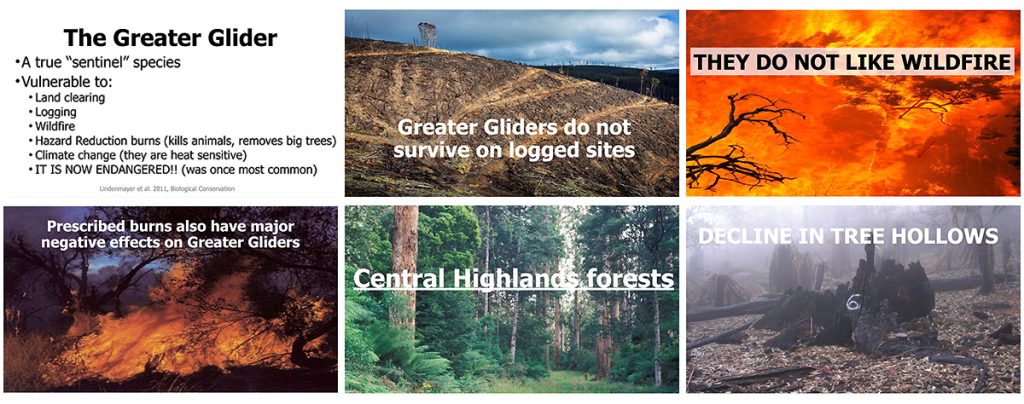
Greater gliders were very common and are now endangered due to logging and fire which reduces tree hollows
Research by Professor Phil Zylstra shows that the forest’s naturally self-thinning understory can reduce fire risk even amid climate change.
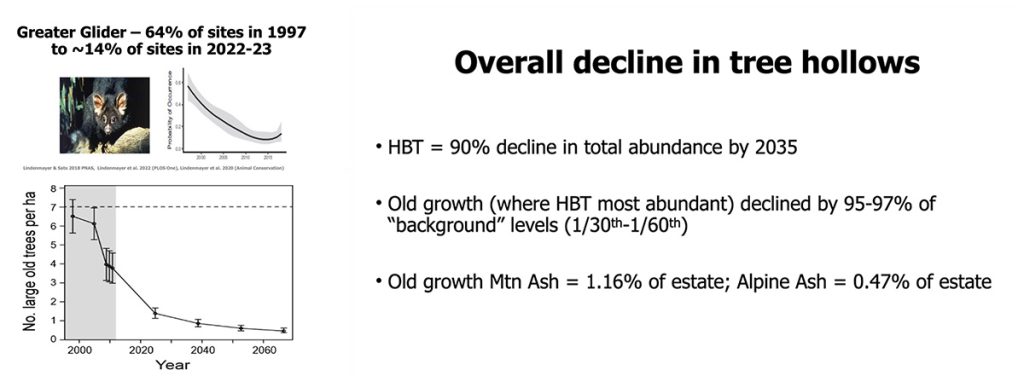
The Greater Glider requires very mature trees with nesting hollows (HBT) for survival
Voices from Citizen Scientists
Sue McKinnon and Aawa White of Kinglake Friends of the Forest shared the reality and triumphant moments of citizen science in the Toolangi Forest.
Sue McKinnon

Sue McKinnon, President of Kinglake Friends of the Forests talking about the long process and eventual legal victory against VicForests
Sue discussed the vital role that on-the-ground activism and hard evidence played in building a legal case against VicForests.

Native forest logging and burning is not finished in Victoria
Aawa White
Aawa spoke of her deep-rooted commitment and love for the forests and the need to document what is being lost.

“no basis for ceasing timer harvesting” at Spyglass coupe “sufficient habitat is being retained”: DEWLP
The documentation can then be used to mount cases in courts. It requires training community members to be able to carry out citizen scientist data collection. That data is vital to build cases to challenge the government departments that do not uphold the principles of sustainable development.

Map of citizen surveys, producing more evidence, admissible in court, about threatened species
Aawa has developed training guides for citizen scientists. Aawa led our Lighter Fooptrints / ACF Boroondara Citizen Science training session in May and our Family Forest Spotlighting event on 17 September. We anticipate repeating these events in 2024.

Prof David Lindenmayer, Sue McKinnon and Aawa White answer questions from a very engaged audience
Actions we can take right now!
1) The Greater Glider Nest Box project with ANU
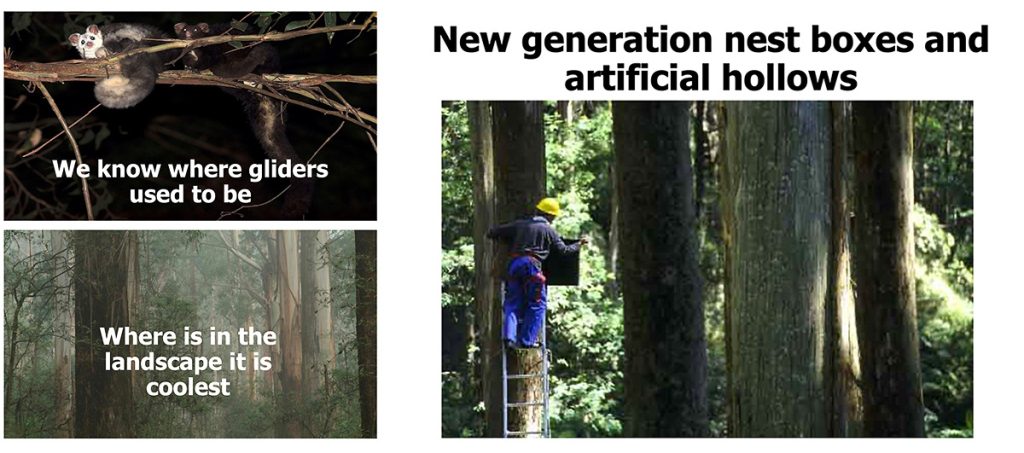
The Greater Glider Restoration Project is an initiative of ANU providing fire resistant insulated nesting boxes in the context of scientific research
Hollow -bearing trees essential for shelter and nesting have been lost with our old growth trees and forests, and can take 170 years to form in regenerating trees. We don’t have time to wait.
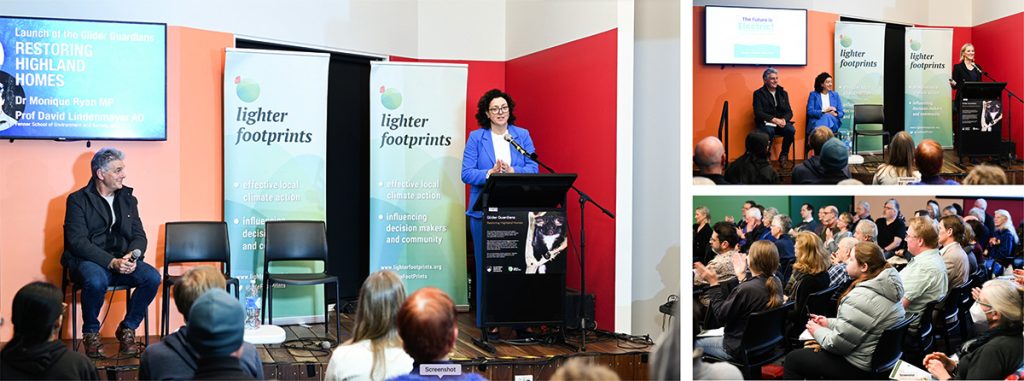
Dr Monique Ryan MP and Prof David Lindenmayer launch the Greater Glider nest box project – Restoring Highland Homes
To combat this loss, ANU has initiated the Greater Glider recovery project that will support populations of greater gliders by deploying purpose-built, well insulated, fire retarding nest boxes and artificial hollows at nesting sites where greater glider populations require support to recover.
This conservation program will be research-based, with a focus on data collection within a statistically robust framework. It will also involve long-term monitoring and community engagement, including involvement with First Nations people.

Congratulations to Lighter Footprints Forests Working Group for a very successful event, and thanks to Dr Monique Ryan MP for launching the Greater Glider nesting box project
Be part of the Greater Glider recovery project!
You can support the ANU project and be part of science-driven initiatives toward forest restoration and recovery by visiting the project’s website.
2) Citizen Science – take the Hollow-bearing Tree Challenge
- Download the iNaturalist App on your phone – Google Play, Apple Store
- Pack a picnic lunch and head to one of these locations next to a planned burn area (find out more on Aawa White’s A4 instruction sheet here)
- Take a walk and take pictures of one or more hollow bearing trees within the planned burn area
- Upload your pictures to the iNaturalist app
- (Final step) Send your detections to Forest Fire Management Victoria – instructions on the sheet (in easy to read/download A4 format).
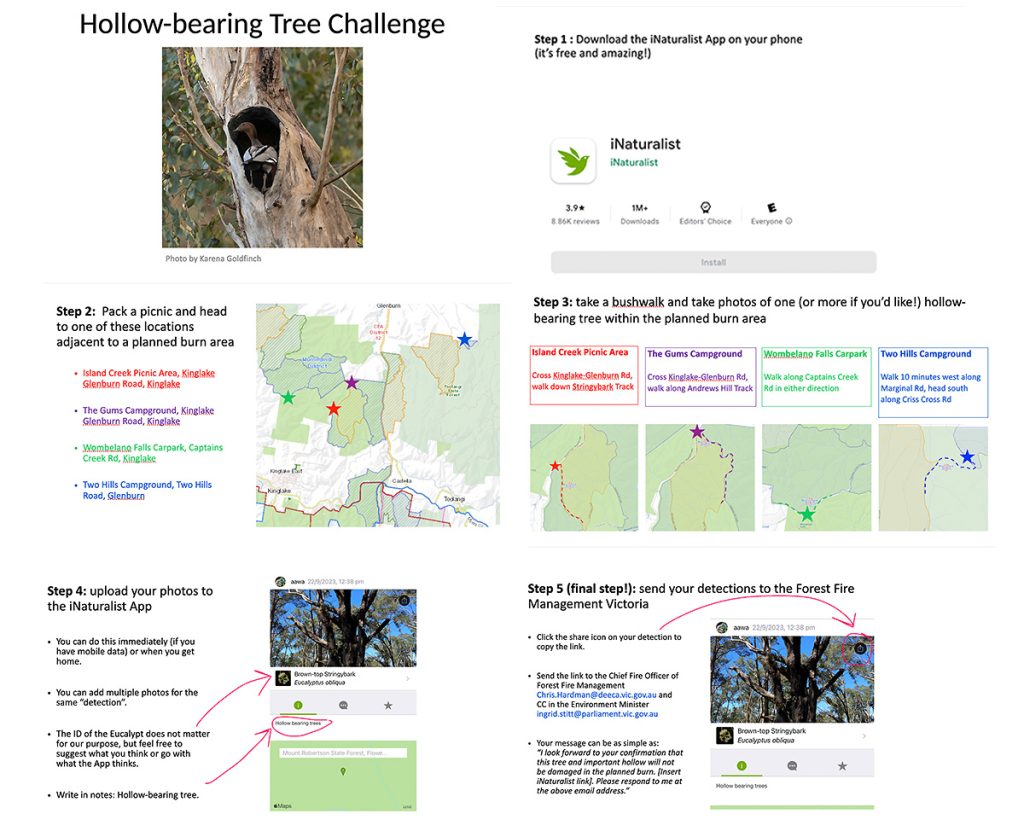
Be part of the citizen science movement, and add the locations of hollow bearing trees, data that when logged can help protect our forests and preserve highland homes

